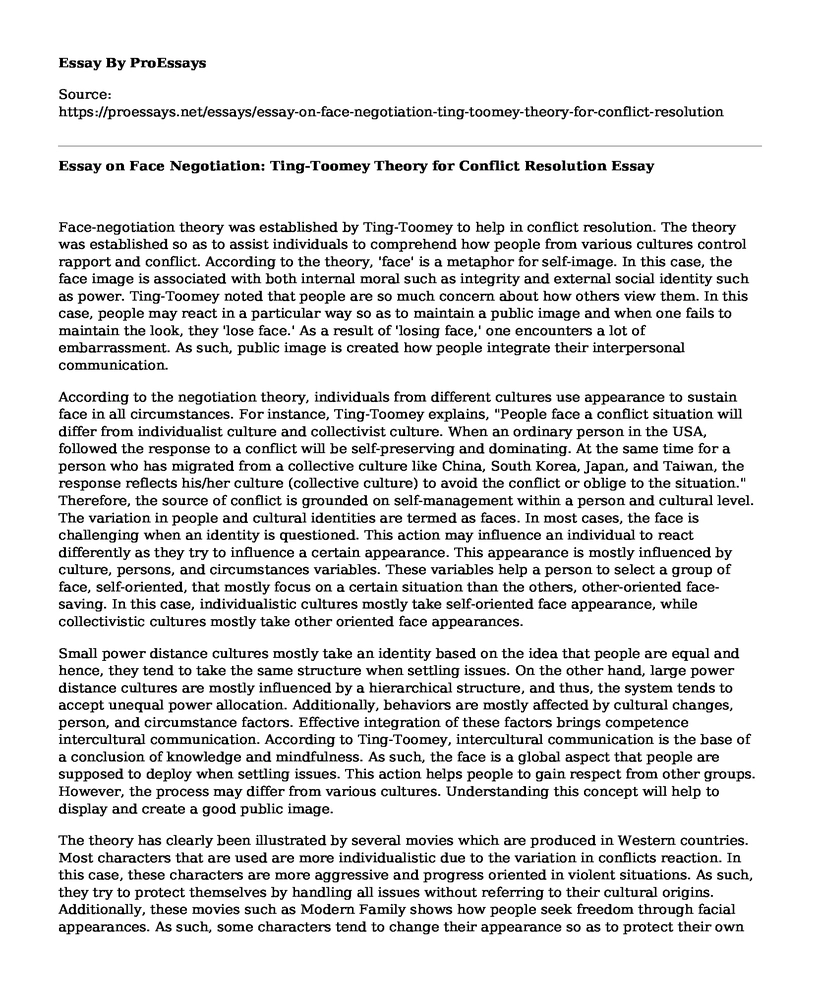Face-negotiation theory was established by Ting-Toomey to help in conflict resolution. The theory was established so as to assist individuals to comprehend how people from various cultures control rapport and conflict. According to the theory, 'face' is a metaphor for self-image. In this case, the face image is associated with both internal moral such as integrity and external social identity such as power. Ting-Toomey noted that people are so much concern about how others view them. In this case, people may react in a particular way so as to maintain a public image and when one fails to maintain the look, they 'lose face.' As a result of 'losing face,' one encounters a lot of embarrassment. As such, public image is created how people integrate their interpersonal communication.
According to the negotiation theory, individuals from different cultures use appearance to sustain face in all circumstances. For instance, Ting-Toomey explains, "People face a conflict situation will differ from individualist culture and collectivist culture. When an ordinary person in the USA, followed the response to a conflict will be self-preserving and dominating. At the same time for a person who has migrated from a collective culture like China, South Korea, Japan, and Taiwan, the response reflects his/her culture (collective culture) to avoid the conflict or oblige to the situation." Therefore, the source of conflict is grounded on self-management within a person and cultural level. The variation in people and cultural identities are termed as faces. In most cases, the face is challenging when an identity is questioned. This action may influence an individual to react differently as they try to influence a certain appearance. This appearance is mostly influenced by culture, persons, and circumstances variables. These variables help a person to select a group of face, self-oriented, that mostly focus on a certain situation than the others, other-oriented face-saving. In this case, individualistic cultures mostly take self-oriented face appearance, while collectivistic cultures mostly take other oriented face appearances.
Small power distance cultures mostly take an identity based on the idea that people are equal and hence, they tend to take the same structure when settling issues. On the other hand, large power distance cultures are mostly influenced by a hierarchical structure, and thus, the system tends to accept unequal power allocation. Additionally, behaviors are mostly affected by cultural changes, person, and circumstance factors. Effective integration of these factors brings competence intercultural communication. According to Ting-Toomey, intercultural communication is the base of a conclusion of knowledge and mindfulness. As such, the face is a global aspect that people are supposed to deploy when settling issues. This action helps people to gain respect from other groups. However, the process may differ from various cultures. Understanding this concept will help to display and create a good public image.
The theory has clearly been illustrated by several movies which are produced in Western countries. Most characters that are used are more individualistic due to the variation in conflicts reaction. In this case, these characters are more aggressive and progress oriented in violent situations. As such, they try to protect themselves by handling all issues without referring to their cultural origins. Additionally, these movies such as Modern Family shows how people seek freedom through facial appearances. As such, some characters tend to change their appearance so as to protect their own face.
Cite this page
Essay on Face Negotiation: Ting-Toomey Theory for Conflict Resolution. (2023, Jan 10). Retrieved from https://proessays.net/essays/essay-on-face-negotiation-ting-toomey-theory-for-conflict-resolution
If you are the original author of this essay and no longer wish to have it published on the ProEssays website, please click below to request its removal:
- Big Bang Theory: Introduction to Communication - Essay Sample
- Essay on Gender Roles in Desiree's Baby by Kate Chopin
- Computer Ethics in the Workplace Essay
- Social Learning and the Virtual World Literature Review Paper Example
- Essay Example on US Firm's Tanzania Business: Cultural Challenges for H.G.
- Essay Example on Gambling Addiction: Long-Lasting Consequences on Society
- Overcome Dilemmas: Giving Advice in the Right Way - Essay Sample







